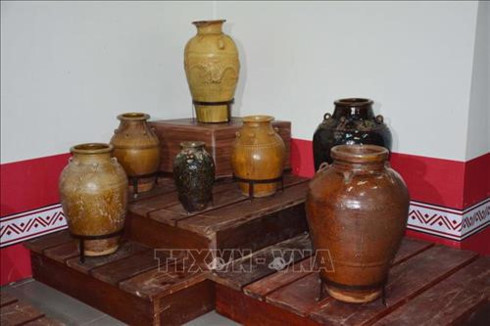 |
|
Some Che jars of the Ede
|
They are polytheists and observe many agricultural rituals. An indispensible item in any worship ceremony is a big jar called a Che used to contain alcohol.
For ethnic groups in the Central Highlands, including the Ede, Che jars are precious assets. Ches are not only alcohol containers, but a family’s treasure. They give Che jars as presents or for compensating others for their mistakes.
In the long houses of the Ede, Ches are outstanding items among bronze pots, gongs, and a Neu tree, which is a high bamboo pole believed to chase evil spirits away. Gongs are sacred items while Che jars represent family’s prosperity and power.
 |
| Some Ches jars worth 7 to 10 buffalos |
H’Be, a curator of Dac Lac province’s Museum, says “Some Che jars worth 7 to 10 buffalos. To evaluate a poor or wealthy family, they count the gongs, Ches, and buffalos. If they have elephants, they are very rich.”
Y Bhiao Mlo displays many valuable Ches of different sizes in his long house in Buon Ho town. Some are empty, some contain alcohol.
Y Bhiao Mlo says he brought Ches from traders and they are worth about ten to a hundred USD.
Now when some traditional rituals are falling into oblivion and antique dealers are seeking for old Ches, it’s not easy for him to buy more.
Y Bhiao Mlo says “I have 20 Ches of 5 types. I just bought an old Tang jar. A fire in 1973 destroyed many Ches of my parents. I cannot buy similar ones. I’m willing to pay for ancient Ches because I want to preserve my group’s tradition. We need them for worship ceremonies and keep them for our children.”
 |
|
Ches are categorized into 4 groups: Tuk, Tang, Ba, and Bo. It is believed that a Che is a shelter of a supernatural power.
|
The Ede must have Ches of alcohol for their new rice ceremony, health praying ritual, birthday anniversary, and funeral ceremony. They are an offering to the God Emperor.
When they buy, sell, or give a Che away as a present, both the giver and the receiver perform a ritual to inform the family genies and ancestors of the event.
If they carelessly break a Che, they hold a ceremony to apologize genies and the owner of the Che.
Ches of alcohol show the hospitality of the house’s owner and the community. VOV5

Ede ethnic people preserve traditional brocade weaving craft
The Ede ethnic people have long been proud of their brocade weaving and are trying to preserve the traditional craft amid the rapid industrialization, modernization, and fashion changes.

Rong communal House inauguration of Bahnar ethnic people
For people in the northern central highlands, new Rong house rite is seen as the most important ceremony of Bahnar ethnic people. This house witnesses important events of the community.

Co Lao ethnic group
The Co Lao, one of Vietnam’s 54 ethnic minority groups, has about 3,000 people. The group settled in Vietnam about 200 years ago and now lives mainly in the northern mountainous region.
 The Ede ethnic minority people in the Central Highlands have developed rich cultural values, which are closely associated with terraced field cultivation.
The Ede ethnic minority people in the Central Highlands have developed rich cultural values, which are closely associated with terraced field cultivation.